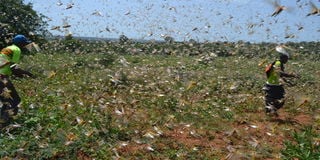Munya says State out to eradicate locusts before long rains

Residents attempt to chase away desert locusts in Kaanwa, Tharaka Nithi County on February 11, 2021.
The government is committed to eliminating desert locusts — which continue to wreak havoc in over 10 counties — before the onset of the long rains expected in April, to prevent further devastation of crops and rangelands.
Agriculture Cabinet Secretary Peter Munya has said that besides the ground and aerial control sparing which is going on in the affected counties, the government is also training local communities on reporting of the swarms so that they are sprayed within the shortest time possible.
“Community level support is very important (in building internal capacity) and will assist in fast reporting of the swarms so that they are sprayed before spreading to other counties,” Mr Munya told journalists in Isiolo town.
Food security threat
The continued destruction of crops and vegetation in the affected counties poses a huge threat to country’s food security and could spark resource-based conflicts in the pastoralist counties.
Farmers in Meru, Tharaka Nithi and Embu have decried the destruction of their crops by the voracious pests and called for immediate intervention.
They lamented that the invasion has threatened their sources of livelihood and that they could incur huge losses if the swarms are not killed.
Counties battling the pests are Wajir, Marsabit, Mandera, Garissa, Samburu, Laikipia, Baringo, Meru, Embu, Tharaka Nithi, Kitui, Machakos, Makueni and Nyandarua. The infestations in Isiolo, Kilifi, Lamu, Tana River and Nakuru have been decimated.
Multiple reports
While counties in northern and central region continue to battle numerous immature swarms, officials say the infestations were spotted many times in different parts, resulting to multiple reports of same swarm.
Last week, Government Spokesman Cyrus Oguna said 156 swarms of the 303 reported in the affected counties had been eliminated.
While swarms arriving in Kenya from Somalia and Ethiopia are declining, authorities are worried over the expected rains which will multiply the locusts’ population and facilitate maturation and breeding.
Mr Munya said the government is considering creating a well-funded commission to deal with locusts as the current structure is not effective enough as expected.
Disaster preparedness
“We will also mainstream disaster preparedness and pest control in dealing with unforeseen emergencies like the invasion by migratory pests,” he noted.
The government, he said, still faces challenges in tracing the swarms in vast northern Kenya and asked residents to report once they spot the pests for necessary action to be taken.
“We are not out of danger yet because the expected rains will offer a breeding environment for the locusts. We will keep monitoring the situation and providing necessary interventions,” the CS said.
Regional coordination
Mr Munya said lack of proper regional coordination between countries in the Horn Africa is a major hindrance to the desert locusts’ fight.
In Somalia, new immature swarms continue to breed in the northeast where hopper bands persist near the coast while immature swarms persist in Oromia, Ethiopia.
The Food and Agriculture Organisation, in its February 16 update, called for intensified aerial and ground control operations in Kenya and the neighbouring countries to eliminate the pests before they mature and start laying eggs.
Immature swarms have also been spotted on the southern coast of the Red Sea in Sudan while small adult groups continue to form in adjacent areas of Eritrea.





